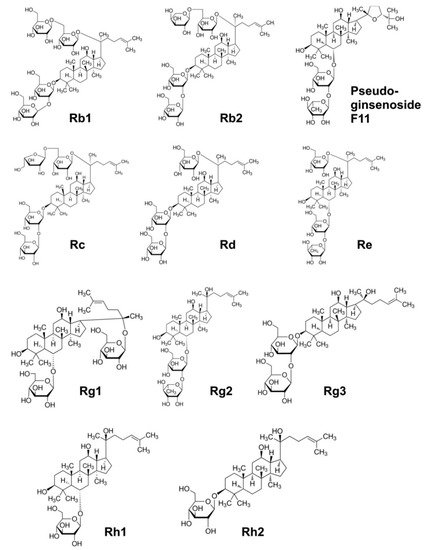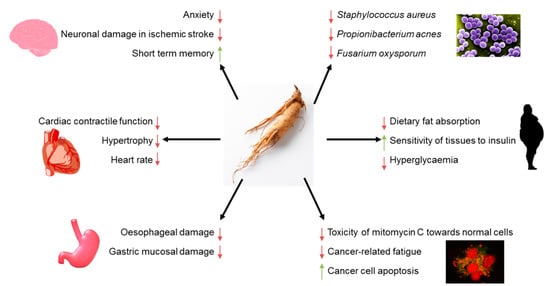2. American Ginseng: Cultivation, Characteristics, and Applications
The
Panax genus plays an important role among natural compounds applied in human healthcare. Within its 11 species, the three most commonly used are
Panax ginseng (Asian ginseng),
Panax notoginseng and
Panax quinquefolium (American Ginseng). All three species have received significant attention due to their profitable features and have been implemented in healthcare products and food additives all over the world [
13,
14,
15]. North Asia countries, namely eastern regions of China, Japan, and Korea are abundant in Asian ginseng. Notoginseng is an herbal pharmaceutical of Chinese origin and is cultivated mainly in China [
16,
17].
AG as opposed to Asian ginseng and notoginseng is an herb characteristic for regions of North America. It inhabits areas from Quebec to Manitoba in Canada to Georgia, Louisiana, Arkansas, and Oklahoma in the United States [
18]. The greatest area of AG cultivation is located in Wisconsin [
19]. Since 1980s this species of ginseng is also cultivated in China [
20].
AG represents perennial, forest herbs [
21]. Individual leaves vary in shape from lance to oblong ones. In the summer small flowers of white colour appear. They are located on a simple umbel within the major leaf axis. The appearance of flowers is followed by berry-like red fruits that contain up to three seeds. Ginseng roots are variably branched and have fleshy white colour. Sometimes, when the plant grows older, it displays an auxiliary root that can be used as a “spare” in the event of damage of the major root [
22].
AG is fertilized by generalist insects such as small Halictid bees and has a mixed-mating breeding system. Its process of reproduction is based exclusively on seeds and occurs after a pre-reproductive period that lasts about 3 years. First, green fruits appear in July and August and they accomplish maturity and redness between August and November [
18]. Harvesting of roots is possible after 4 years from seeding. However, it should be underlined that cultivated roots are usually harvested after 3–4 years of growth, while wildly grown ginseng is usually harvested at the 8th year of growth or later [
23,
24].
Thermally processed ginseng roots can be classified into 2 types: fresh (red) and dried (white) [
25]. Roots that are subjected to sun dehydration are called white ginseng. Red ginseng is the one after thermal processing with application of steam and high temperature that result in damage to enzymes that cleave active compounds [
26]. This procedure stabilizes ginseng without changes in its activity, which is the same as the activity of fresh root. Such thermal processing of ginseng roots also prolongs their shelf life, so dried roots are preferable in natural Asian medicine. Both forms of AG have similar chemical compositions and pharmacological properties [
27].
Ginseng medical application in Eastern Europe dates back 2000 years. However, the name of the genus,
Panax (
pan from Greek means “all”,
anox means “treat” which altogether can be understood as “treats all diseases”) was given to it in the first half of the 19th century by Russian scientist Carl Meyer [
28].
Varieties of products containing AG are currently available on the market, starting from powders and pellets, ending up on teas. There are roots of ginseng in a form of dried shredded slices and extracts of this plant. Ginseng dried flowers or flakes are also available [
29]. In many countries ginseng is being implemented in hair conditioners, shower gels, lotions, and shampoos. Its roots and rhizomes are used as diet supplements, drugs, and finally as food. In the USA there are candies and drinks containing AG extract; in Korea, soups and salads containing ginseng are common, while in China ginseng extract is added to alcoholic beverages [
27,
28,
29,
30].
3. Bioactive Phytochemicals of American Ginseng
Bioactive compounds responsible for variety of beneficial activities of AG in humans are called ginsenosides or panaxosides. From the chemical point of view, these compounds are glycosides consisting of a non-sugar part—an aglycone and a sugar chain or chains. In the chemical structure of ginsenosides, three types of aglycones can be distinguished: tetracyclic of dammarane type, pentacyclic of oleanolic acid type and tetracyclic of the ocotillol type.
The sugar part of saponins includes hexoses (glucose, galactose), 6-deoxyhexoses (furanose, rhamnose), pentoses (arabinose, xylose) and uronic acids (glucuronic acid). They are usually in cyclic form and are linked to the aglycone by semi-acetal bonds [
31,
32].
Ginsenosides are designated “Rx”, where “R” means root, and “x” describes, in alphabetical order, the polarity of the compound according to their mobility on thin layer chromatography plates, from index “a” to “h”. For example, the Ra metabolite is the least polar compound. Most ginsenosides consist of a dammarane skeleton with 17 carbon atoms arranged in four rings. Due to the number of hydroxyl groups these compounds can be classified into two main categories: protopanaxadiol (PPD) and protopanaxatriol (PPT) [
33].
Protopanaxadiols are the dammarane-type ginsenosides with sugar moiety at C-3 and/or C-20. Their structures are also characterized by a linear linkage between glycosyl chains and acylation occurring at the 6-OH of the terminal glucose of a three-sugar chain. Within this group the Rb1, Rb2, Rb3, Rc, Rd, Rg3, and Rh2 can be distinguished. Over 30 ginsenosides belonging to PPD type are classified to the Rb group. Protopanaxatriols are dammarane-type ginsenosides and they include ginsenosides Re, Rf, Rg1, Rg2, Rh1, F1, F3 and notoginsenoside R1. However, in the PPT moiety there is a hydroxyl group at C-6 distinguishing them from PPD [
34,
35]. Other features of PPT structures are at most two glycosyl chains and a linear linkage of saccharide chains [
34]. Ginsenosides Rb1, Re, Rd, Rg1 and Rb3 are considered as six major saponins and make up more than 70% of total ginsenoside content in AG [
35].
Another constituent is oleanolic acid, which contains a pentacyclic triterpene skeleton [
36]. Its derivative is ginsenoside Ro [
37]. Last but not least ocotillol that has a five-membered epoxy ring at C-20 needs to be mentioned [
38]. An example of ocotillol-type panaxoside isolated from the roots and leaves of AG is pseudoginsenoside F11 (p-F11) [
39].
Two ginsenosides are considered as major marker compounds that could discriminate
P. ginseng and AG. These are ginsenoside Rf, present in Asian ginseng and p-F11occurring in AG [
40]. It was documented that AG is a source of unsaturated fatty acids, including linolenic acid, which is especially important as its consumption decreases frequency of chronic diseases such as arrhythmia and arthritis [
41]. Furthermore, ginseng roots contain polysaccharides. They are made up of a complex chain of monosaccharides rich in
l-arabinose,
d-galactose,
l-rhamnose,
d-galacturonic acid,
d-glucuronic acid and
d-galactosyl residues [
42]. Wang et al. isolated a novel neutral polysaccharide from the roots of AG [
43]. Monosaccharide composition analysis demonstrated that it consisted of glucose and galactose in a molar ratio 1:1.15. It was observed to hinder inflammation by inhibition of inflammatory-related mediator nitric oxide (NO) and cytokines, including tumor necrosis factor (TNF), interleukin 6 (IL-6), and interleukin 1. This indicates AG potential for application in diseases linked with inflammation, including atherosclerosis [
43].
Apart from saponins and polysaccharides AG contains terpenes, phenolic compounds, amino acids, flavonoids, volatile oils, vitamins, and minerals [
44,
45]. A study conducted by Kochan et al. indicated that the content of triterpene saponins in hairy root cultures of AG can be increased by application of
trans-anethole as elicitator [
46]. It was observed to stimulate production of 9 different ginsenosides: Rb1, Rb2, Rb3, Rc, Rd, Rg1, Rg2, Re, and Rf, among which the Re metabolite was documented with the highest rate of production, 3.9 fold in comparison to untreated root [
46].
Although all ginseng plants contain either protopanaxadiols (PPD group) or protopanaxatriols (PPT group), their compositions may be different. Asian ginseng contains mainly Rb1, Rb2, and Rg1 ginsenosides [
47]. Notoginseng is rich in ginsenosides Rb1, Rd, Rg1 and notoginsenoside R1, while AG in ginsenosides Rb1, Rd and Re [
47]. It was also observed that the same species of AG cultivated in different locations display differences in chemical composition, including content of active compounds, and because of that they display different health beneficial activities [
48,
49]. In addition, many reports confirm that with the age of ginseng plant, the content of saponins increases [
23,
50,
51]. It is also worth mentioning, that although pharmacopoeia raw material of ginseng is root, ginsenosides also occur in other organs of ginseng plant such as: leaves, stems, fruits, and even in small amounts in the seeds [
50,
52]. Chemical structure of some AG ginsenosides, as well as their pharmacological activities are presented in
Figure 1 and
Table 1, respectively.
Figure 1. Chemical structure of main ginsenosides present in American Ginseng.
Table 1. Main ginsenosides of American Ginseng and their pharmacological activity.
|
Pharmacological Action
|
Ginsenoside
|
Reference
|
|
Positively affects memory processes; induces synthesis of acetylcholine in the hippocampus by stimulating choline acetyltransferase; induces apoptosis and inhibits angiogenesis in cancer cells; inhibits the release of inflammatory leukotrienes; reversibly and tonically blocks voltage-dependent Na+ channels in the brain reducing detrimental effects of hypoxia; downregulates the COX-2 gene; stabilises neutrophils and lymphocytes; inhibits the release of histamine; blocks calcium channels and stabilised the heart; reduces blood sugar levels; anti-diabetic, insulin-sensitising and anti-obesity actions; neurotropic, neuroprotective, oestrogen-like activity; stimulates GABA receptors and induces a depressive effect on brain function, which underlines its calming, anxiolytic, sleeping, relaxing and antipsychotic effects
|
Rb1, Rb2, Rc
|
[9,22,53,54,55]
|
|
Stimulates superoxide dismutase; inhibits angiogenesis in cancer; prevents diabetes; lowers cholesterol and triglycerides levels, activates lipolysis; corticotropic and oestrogenic activity
|
Rb2
|
[9,54,55]
|
|
Inhibits proliferation of breast cancer cells; induces corticotropic effects
|
Rc
|
[9,22,54]
|
|
Promotes neurites outgrowth, an important process for neuronal repair; induces corticotropic effects
|
Rd, Rc, Re
|
[9,22,54,55,56,57]
|
|
Scavenges hydroxyl radicals and degrades H2O2; reduces blood sugar levels; induces cardioprotective effects; activates cGMP and relaxes smooth muscles
|
Re
|
[9,22,54,55,56]
|
|
Downregulates the COX-2 gene; stabilises neutrophils and lymphocytes; inhibits histamine release; inhibits platelet-induced activation of thromboxane; increases insulin receptors; increases T-helper lymphocytes; inhibits release of endothelin and relaxation of the smooth muscle of blood vessels; activates cyclic guanosine monophosphate and relaxes the smooth muscle (hypotensive effect); blocks calcium channels and stabilised the heart; reduces blood sugar levels
|
Rg1
|
[22,55,56]
|
|
Inhibits neuronal acetylcholine
|
Rg2
|
[22]
|
|
Inhibits platelet aggregation induced by thrombin; relaxes the smooth muscle of the blood vessels by activating the K+ channels and releases Ca2+; inhibits progression of tumours and reduces drug resistance of cancer cells; inhibits endothelin and relaxation of the smooth muscle of blood vessels; induces hypotensive effect; downregulates the COX-2 gene; stabilises neutrophils and lymphocytes; inhibits histamine release; modulates mitogen-activated protein kinases, thus inhibiting the spread of cancer cells
|
Rg3
|
[22,53,55,56,58]
|
|
Activates oestrogen receptor; inhibits proliferation of cancer cells and induces apoptosis
|
Rh1
|
[22,58]
|
|
Inhibits breast, liver and prostate cancer cells proliferation
|
Rh2
|
[22,58]
|
|
Assists memory improvement; induces neuroprotective effects
|
Pseudoginse-noside F11
|
[22]
|


